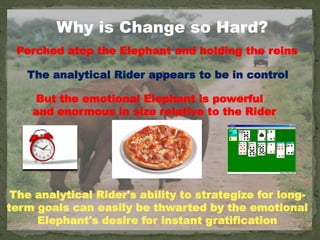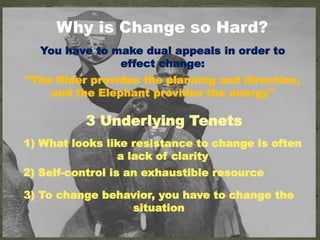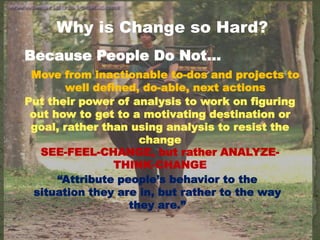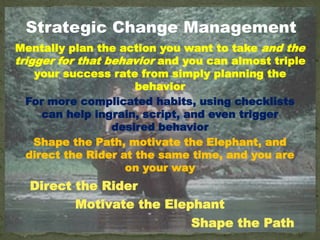The Elephant And The Rider Lessons About Change
- 1. The Elephant and the Rider: Lessons About Change
- 2. Why is Change so Hard? Rational mind: Rider Analytical and slow to act Emotional mind : Elephant Impulsive and susceptible to habit
- 3. Why is Change so Hard? Perched atop the Elephant and holding the reins The analytical Rider appears to be in control But the emotional Elephant is powerful and enormous in size relative to the Rider The analytical Rider's ability to strategize for long- term goals can easily be thwarted by the emotional Elephant's desire for instant gratification
- 4. Why is Change so Hard? The Elephant isn't always the bad guy He has strengths as well as weaknesses, as does the Rider In his capacity for emotion, the Elephant can supply the energy and determination needed to reach a goal The Rider, on the other hand, despite his analytical ability, can actually slow down progress if he is unable to stop analyzing and reach final decisions
- 5. Why is Change so Hard? You have to make dual appeals in order to effect change: "The Rider provides the planning and direction, and the Elephant provides the energy" 3 Underlying Tenets 1) What looks like resistance to change is often a lack of clarity 2) Self-control is an exhaustible resource 3) To change behavior, you have to change the situation
- 6. Why is Change so Hard? 3-point pattern for change Direct the Rider: Indecision Slows Progress Define your goals--not just your ultimate goal, but each step--script your critical moves Motivate the Elephant: Let Him Dream Your Dream “Find the feeling" and “Shrink the change" You can't move the Elephant with facts; you have to generate enthusiasm for the destination Give the Elephant a series of small goals leading to small successes, and larger goals will seem to shrink Shape the Path: Tweak the Environment If you are in a setting that is not conducive to your success, your goal becomes that much more elusive
- 7. Why is Change so Hard? Because People Do Not… Move from inactionable to-dos and projects to well defined, do-able, next actions Put their power of analysis to work on figuring out how to get to a motivating destination or goal, rather than using analysis to resist the change SEE-FEEL-CHANGE, but rather ANALYZE- THINK-CHANGE “Attribute people’s behavior to the situation they are in, but rather to the way they are.”
- 8. Strategic Change Management Mentally plan the action you want to take and the trigger for that behavior and you can almost triple your success rate from simply planning the behavior For more complicated habits, using checklists can help ingrain, script, and even trigger desired behavior Shape the Path, motivate the Elephant, and direct the Rider at the same time, and you are on your way Direct the Rider Motivate the Elephant Shape the Path
- 9. References









